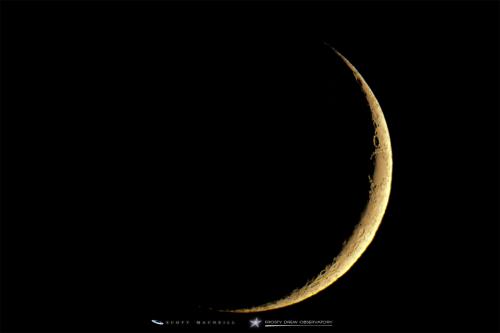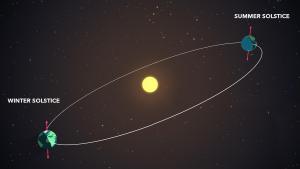Celebration of Space - June 16, 2023

The super thin 6% waxing crescent Moon. Credit: Frosty Drew Astronomy Team member, Scott MacNeill, captured this image with the Meade 16 inch telescope.
This coming Sunday, June 18, 2023, at 12:39 am ET, the Moon will arrive at the point in its orbit around Earth, where it passes in between Earth and the Sun. Astronomers call this Conjunction, but nearly everyone else calls it the New Moon. On the day of the New Moon, the Moon will rise and set with the Sun, leaving the nighttime period completely free of moonlight. Even though this is the best night to be out celebrating the cosmos, there are other nights around the new Moon that are, pretty much, just as good. Unfortunately, clouds and rain will persist through the night of the new Moon, which will be overnight Saturday into Sunday this weekend. But once the new Moon passes, the super thin waxing crescent will return to the afternoon dusk sky, offering up beautiful views of Earthshine, which is when the nighttime side of the Moon is dimly illuminated by sunlight that is reflecting off of Earth. Now that school is out for the summer, take a moment this week to get the family outside just after sunset, and catch a view of the stunning crescent Moon.
It’s that time of the year again, when astronomers complain about the super short nights, and everyone else celebrates the long days, and what better way to celebrate than to welcome the Summer Solstice, which will occur on Wednesday, June 21, 2023 at 10:58 am ET.
The Summer Solstice occurs when Earth orbits into a position where the Northern Hemisphere is tilted at maximum tilt, 23.4°, towards the Sun. The Summer Solstice also marks the first day of summer in the north. On Wednesday, the Sun will pass directly overhead at noon along the Tropic of Cancer, and will bring the shortest nighttime period of the year in the north. The Arctic Circle will see the Midnight Sun, and the Antarctic Circle will see Polar Night. This may be an awesome time for heat loving zealotry, but the super short nights make it a tough time for astronomy. Allowing for only 4.5 hours of dark sky conditions outside of twilight. Regardless, beach days, summer break, BBQ, mosquitoes, wildfire smoke, awesome sunsets, picnics, and sunburn are here for the next few months. Whether you hate it or love it, step out on Wednesday and feel the heat of the Summer Solstice and welcome summer. Have a happy Summer Solstice from all the astro-geeks at Frosty Drew Observatory and Science Center.
On June 4, 2023, Venus reached its third quarter phase, which is when we see half of the area on Venus that is in direct sunlight, and half of the area that is in shadow. Third quarter also means that Venus is waning, and has since entered its waning crescent phases, which are the best times to catch a view.
Venus orbits the Sun in a counterclockwise manner. When Venus is on the opposite side of the Sun than Earth, we call this Superior Conjunction, which is also the full phase, alternatively, when Venus is between Earth and the Sun, we call this Inferior Conjunction, which is the new phase. Since we are past third quarter, Venus is quickly approaching inferior conjunction, which will happen on August 13, 2023. During this approach, not only will Venus wane beautifully into a very thin crescent, it will also continue to orbit towards Earth, which will increase the angular size of Venus significantly. Angular size is the size of Venus we see when we look at it in the sky, which is much more noticeable in a telescope. The only disadvantage of Venus approaching inferior conjunction is that the planet is getting visibly much closer to the Sun, which makes observations increasingly difficult. Regardless, now is the time to get out and see Venus, and you can’t miss it as it’s the third brightest object in the sky after the Sun and the Moon. Just step outside during twilight and look over the western sky for that super bright star-like object.
Evening passes of the China National Space Administration’s Tiangong space station continue this weekend and next week. Being that Tiangong has a different orbital inclination than the International Space Station, we get much higher passes of Tiangong over our region, which make for spectacular pass viewing opportunities. Here are several notable passes of Tiangong over our region for the next week:
Fri, Jun 16 at 9:06 pm, starting in the SW, rising to 31°, heading towards the E.
Fri, Jun 16 at 10:43 pm, starting in the W, rising to 68°, and into orbital sunset ← Awesome pass!
Sat, Jun 17 at (:44 pm, starting in the WSW, rising to 68°, heading towards the E, and into orbital sunset ← Awesome pass!
Sun, Jun 18 at 10:22, starting in the W, rising to 86°, heading towards the E, and into orbital sunset ← Awesome pass!
Mon, Jun 19 at 9:23 pm, starting in the W, rising to 86°, heading towards E ← Awesome pass!
Mon, Jun 19 at 11:00 pm, starting in the W, rising to 42°, and into orbital sunset
Tue, Jun 20 at 10:01 om, starting in the W, rising to 88°, heading towards the E, and into orbital sunset ← Awesome pass!
Wed, Jun 21 at 9:02 pm, starting in the W, rising to 86°, heading towards the E, and into orbital sunset ← Awesome pass!
Wed, Jun 21 at 10:39 pm, starting in the W rising to 52°, and into orbital sunset
Thu, Jun 22 at 9:40 pm, starting in the W, rising to 78°, heading towards the ESE, and into orbital sunset ← Awesome pass!
That list is just ridiculous! Look at all those awesome passes, sometimes more than once per night. This is probably one of the best week’s we have had to observe Tiangong. So get out there and catch a view of the station zooming overhead.
- Author:
- Scott MacNeill
- Entry Date:
- Jun 16, 2023
- Published Under:
- Scott MacNeill's Columns



